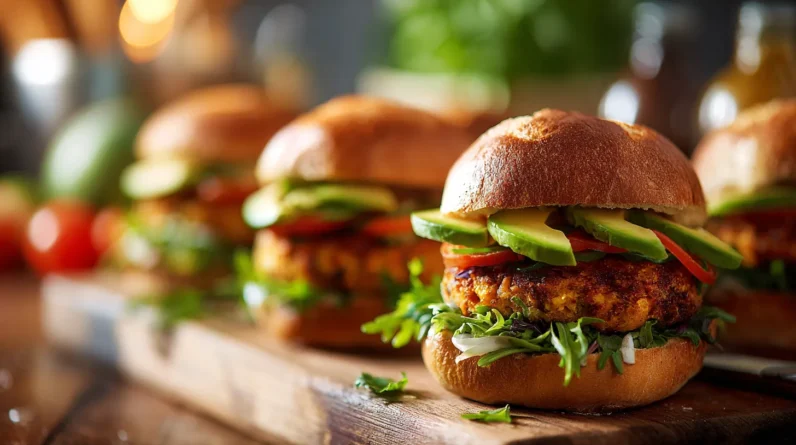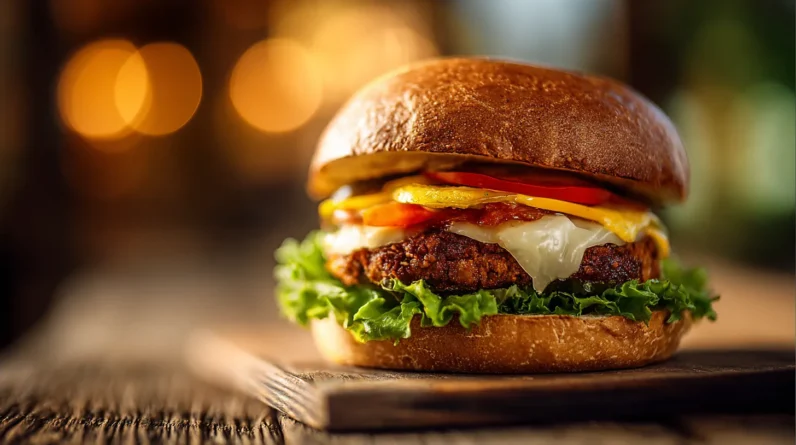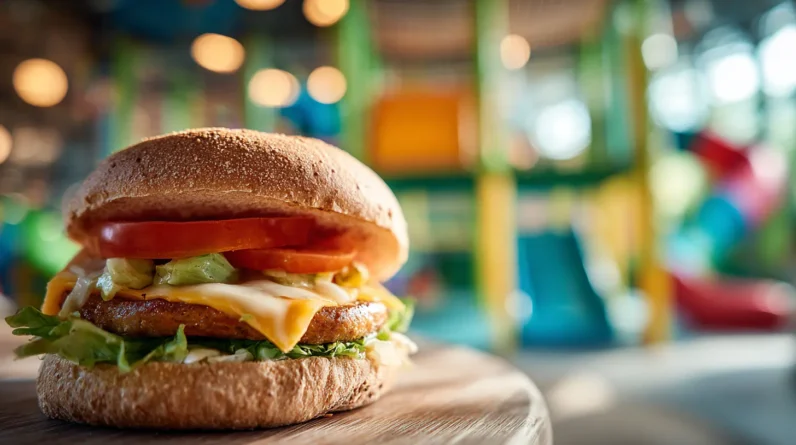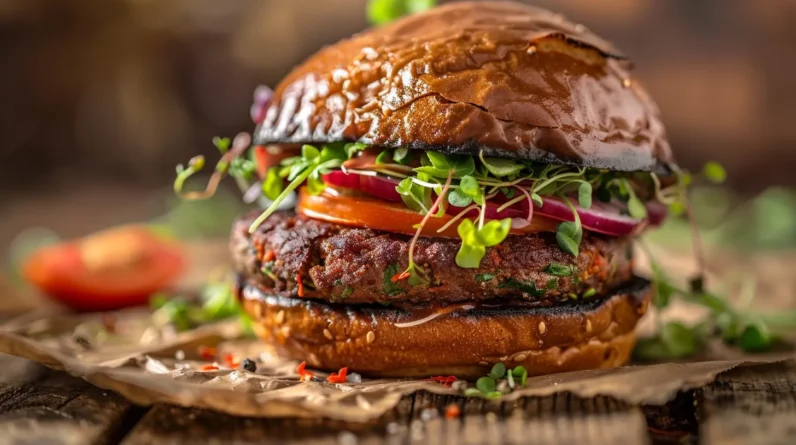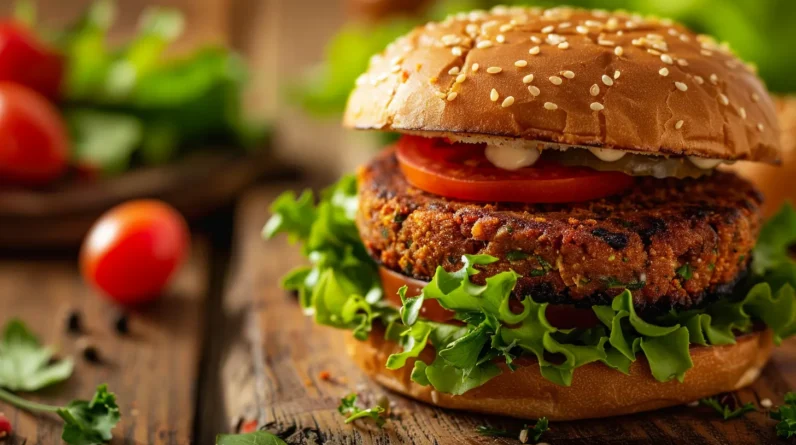
Gluten-free veggie burgers offer safe, nutritious options for those avoiding gluten while pursuing plant-based eating. We’ll find several approaches, from store-bought alternatives like Beyond Meat and Dr. Praeger’s to homemade patties using legumes, vegetables, and gluten-free binders. Key ingredients include black beans, chickpeas, quinoa, and certified gluten-free oats, combined with natural binding agents like psyllium husk. We can prepare these burgers through pan-frying or baking, guaranteeing proper temperature control and minimal handling to maintain integrity. Whether choosing commercial or homemade options, proper ingredient verification and cooking techniques guarantee peak results. Let’s explore the specific ingredients and methods that create the perfect gluten-free veggie burger.
Understanding Gluten-Free Veggie Burgers
The shift toward gluten-free veggie burgers represents a significant advancement in plant-based alternatives for those with celiac disease or gluten sensitivity. We’ve seen manufacturers replace traditional wheat-based binders with innovative ingredients like chickpea flour, quinoa, and psyllium husk to maintain structural integrity while eliminating gluten proteins.
Understanding gluten-free veggie burgers requires recognizing their core components: legumes, vegetables, alternative grains, and natural binding agents. We’ll often find ingredients like black beans, lentils, or pea protein forming the base, while rice, cornmeal, or certified gluten-free oats provide texture. These ingredients must work synergistically to create a cohesive patty that won’t crumble during cooking. When selecting commercial options, we need to verify certification standards and cross-contamination protocols to guarantee complete gluten exclusion.
Popular Plant-Based Patty Ingredients
Building on our understanding of gluten-free foundations, several key plant-based ingredients have emerged as standout options for creating satisfying veggie patties. We’ve identified legumes like chickpeas, black beans, and lentils as protein-rich bases that provide excellent binding properties. These pulses offer essential amino acids while maintaining structural integrity during cooking.
Vegetables such as mushrooms, sweet potatoes, and cauliflower contribute vital moisture and texture, while adding beneficial micronutrients and fiber. We’ll often incorporate nuts and seeds – particularly ground almonds, walnuts, and chia seeds – which provide healthy fats and help achieve the desired consistency. These ingredients not only guarantee our patties remain gluten-free but also deliver ideal nutritional profiles. For enhanced umami flavor, we recommend incorporating sun-dried tomatoes, nutritional yeast, or roasted garlic.
Cooking Methods and Tips
Mastering proper cooking techniques guarantees your gluten-free veggie burgers achieve ideal texture and flavor while maintaining their structural integrity. We’ll need to take into account multiple cooking methods, each offering distinct advantages for different patty compositions.
For pan-frying, we recommend preheating the skillet to medium-high and using a thin layer of high-smoke-point oil. Cook patties for 4-5 minutes per side until they’re golden brown. If baking, we’ll set the oven to 375°F (190°C) and cook for 20-25 minutes, flipping halfway through.
To prevent crumbling, we must make sure patties are thoroughly chilled before cooking. It’s important to avoid excessive flipping during cooking, and we’ll only turn them once. A well-oiled, non-stick surface is vital for maintaining patty cohesion.
Store-Bought Versus Homemade Options
Choosing between store-bought and homemade gluten-free veggie burgers involves careful consideration of nutritional value, ingredient quality, and preparation time. Store-bought options offer convenience and consistency, but we’ve found they often contain higher sodium levels and preservatives. Leading brands like Beyond Meat and Dr. Praeger’s provide certified gluten-free options, though they’re typically more expensive than conventional varieties.
Homemade veggie burgers allow us to control ingredients and customize flavors while avoiding common allergens. We can incorporate nutrient-dense ingredients like quinoa, chickpeas, and fresh vegetables. While preparation requires more time investment, we can make larger batches and freeze them for future use. By preparing our own patties, we’ll also avoid cross-contamination risks that can occur in commercial manufacturing facilities.
Flavor-Enhancing Toppings and Condiments
With gluten-free veggie burgers as our base, we’ll explore toppings and condiments that maximize both flavor and nutritional benefits. Let’s start with nutrient-dense options like avocado slices, which provide healthy fats and fiber, or caramelized onions rich in antioxidants.
For protein enhancement, we can add a fried egg or cashew-based cheese alternative. Fresh vegetables like arugula, tomatoes, and sprouts introduce essential micronutrients and create textural contrast. When selecting condiments, we’ll want to verify gluten-free certification. Safe options include stone-ground mustard, dairy-free aioli, or homemade guacamole.
We can also incorporate fermented toppings like kimchi or sauerkraut, which provide probiotics and enhance digestive health. For umami depth, consider gluten-free tamari or coconut aminos as alternatives to traditional soy sauce.
Conclusion
Steering through the gluten-free lifestyle while enjoying plant-based burgers is like charting a course through clear waters – it simply requires the right map. We’ve explored nutritious ingredients, cooking techniques, and flavor combinations that make gluten-free veggie burgers both satisfying and safe. Whether opting for store-bought varieties or crafting homemade patties, we’ve demonstrated that maintaining a gluten-free diet doesn’t mean sacrificing the classic burger experience. These alternatives provide essential proteins and nutrients while adhering to dietary restrictions.


